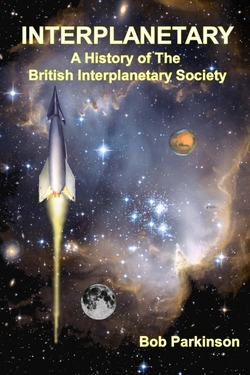Centauri Dreams
Imagining and Planning Interstellar Exploration
The Challenges of Przybylski’s Star
About 370 light years away in the constellation Centaurus is a variable star whose spectrum continues to raise eyebrows. The star is laced with oddball elements like europium, gadolinium, terbium and holmium. Moreover, while iron and nickel appear in unusually low abundances, we get short-lived ultra-heavy elements, actinides like actinium, plutonium, americium and einsteinium. Hence the mystery: How can such short-lived elements persist in the atmosphere of a star? Discovered in 1961 by the Polish-American astronomer Antoni Przybylski, these traits have firmly placed Przybylski’s Star in the Ap class of chemically peculiar stars. Its very name is a cause of continuing conversation.
PRZYBYLSKI'S STAR (HD 101065) Blue dwarf with a peculiar spectrum showing an almost complete absence of vowels.
— FSVO (@FSVO) November 22, 2012
Well, true enough. If Przybylski’s Star is a challenge to understand, it’s also a challenge to pronounce. Charles Cowley (University of Michigan), who offers a detailed analysis of the star online, met Przybylski in 1964, asking him how to say his name. “He obliged me,” Cowley writes, “and I thought I detected a slight “puff” at the beginning of the sound, which Mike Bessel writes is like “jebilskee”, with the “je” as if it were in French. The initial “P” gets minimal sound.” I think we can go with that, although I’ve seen a variety of pronunciations online.
What we’d like to know once we can say the star’s name is how the heavy elements observed here have come about. A neutron star is one solution, a companion object whose outflow of particles could create heavy elements in Przybylski’s Star, and keep them replenished. The solution seems to work theoretically, but no neutron star is found anywhere near the star. In a new paper, Vladimir Dzuba (University of New South Wales) and colleagues suggest that the actinides in Przybylski’s Star are evidence of the slow decay of superheavy elements.
The idea is that there may be a so-called island of stability involving elements with 114 or more protons in their nuclei, super-heavy elements that nonetheless are long-lived. If these exist, then the short-lived plutonium, einsteinium and the rest found in the star would simply be decay products. We may be, in other words, about to discover a new isotope not produced as a fleeting sample in an experiment but as an element observed in nature. That in itself is not unusual: Penn State’s Jason Wright reminds us that helium was first found in the Sun.

Wright has written a four-part discussion of Przybylski’s Star that begins with Przybylski’s Star I: What’s that? and continues through internal links. As with everything Wright does, it’s informative and also hugely entertaining. Moreover, it takes us however briefly into SETI terrain as Wright raises the point that advanced civilizations might use stars to store nuclear waste, a notion broached by Daniel Whitmire and David Wright as far back as 1980, and considered as well by Carl Sagan and Iosif Shklovskii in their Intelligent Life in the Universe (Holden-Day, 1966). Whitmire and Wright even opined that the most likely stars in which we would find such pollution were late A stars like Przybylski’s Star.
Image: Antoni Przybylski in the early 1960’s. Credit: Mike Bessell (via Charles Cowley’s site).
So we can note that this unusual star could fit into the artifact SETI category even as we continue to figure out the natural reasons why it should show the spectrum that it does. Wright adds this interesting note about the entire field of so-called Dysonian SETI, which scours our astronomical data for anomalies that could be the signs of the workings of an advanced civilization. As we continue to see in the controversy over Boyajian’s Star, this area of study can be frustrating, especially when one is in the business of working out what we might find:
This just goes to show that artifact SETI is hard. When people stick their necks out and make bold, silly-sounding predictions about unambiguous technosignatures like this (or like megastructures), I suspect they usually don’t actually expect them to come true. And then when they do come true (as in Przybylski’s Star, KIC 12557548, or Boyajian’s Star) not only are their prediction papers rarely cited (which is, I think, inappropriate), but there’s always immediately a flurry of perfectly natural explanations that arrive to explain things without aliens (which is, I think, totally appropriate).
We keep looking nonetheless because no matter what their origin, stars like Przybylski’s Star are fascinating in their own right. Meanwhile, Dzuba and team hope to pursue the island of stability elements and the idea that the actinides in Przybylski’s Star are the result of their slow and replenishing decay:
We hope that this work provides a motivation for a further progress in the measurements of the transition frequencies for superheavy elements, calculations of the isotope shifts and search for the corresponding transitions in astrophysical spectra.
Dzuba believes the next step should be a search for five elements with atomic numbers of 102 or more: nobelium (102), lawrencium (103), nihonium (113) and flerovium (114), as recounted in this New Scientist report on their work. The challenge is daunting, because while such elements could be part of the radioactive decay chain of stable super-heavy elements on the ‘island of stability,’ their half-lives are so short that their spectra are not well defined.
The original paper on Przybylski’s Star is Przybylski, “HD 101065-a G0 Star with High Metal Content,” Nature Vol. 189, Issue 4766 (1961), pp. 739 ff. (abstract). Amusingly enough, the paper was hidden in plain sight on the Internet for some time, invisible to ADS searches because the author’s name had been misspelled. That has now been fixed. The Dzuba paper is “Isotope shift and search for metastable superheavy elements in astrophysical data,” (preprint).

Looking for Our Sun’s ‘Super-Earth’
An obscure instrument called a blink comparator became world famous following Clyde Tombaugh’s discovery of Pluto in 1930. It was by rapidly switching between astronomical photographs that the young Tombaugh was able to compare objects in the field of view where ‘Planet X’ was presumed to hide. Pluto turned out to be a good deal smaller than Percival Lowell had imagined, leading to thoughts of still more distant planets, but for a time the new planet was best known as a faint dot on a series of plates, moving against a fixed field of stars.

Image: Clyde Tombaugh at the Blink Comparator five years after the Pluto discovery. Credit: Lowell Observatory Archives.
All of this is wonderfully told in Michael Byers’ 2010 novel Percival’s Planet (Henry Holt and Co.), which draws on Tombaugh’s story and depicts the entire Lowell Observatory scene in his time there (see A Tour de Force of Planetary Discovery for my review of the book). Or if you want the inside view, Tombaugh’s own Out of the Darkness: The Planet Pluto takes on his Pluto work and the entire field of planet hunting.
These days we can mimic what a blink comparator did with a computer, but in an era when charge-coupled devices (CCDs) have replaced photographic plates, we’re more prone to use computer software to tease out the motion of distant objects against the background stars, so that the nearby, moving object appears fixed amidst what appear to be the tracks of stars.
We’ll see what technique is to be employed in a new crowdsourced effort to find Planet X, still out there (or so many believe) and referred to by many astronomers as Planet Nine. Brad Tucker (ANU), who leads the project, explains that the new planet is predicted to be a super-Earth, perhaps 10 times the mass of Earth and as much as four times its size.
An object like this roughly 800 AU out would help to explain the unusual orbital characteristics of Sedna and five other ‘extreme trans-Neptunian objects’ (ETNOs) whose orbits are sharply tilted when compared to the plane in which the planets move. Chadwick Trujillo and Scott Sheppard (Carnegie Institution for Science, Washington) made a strong case for this scenario in a 2015 paper, followed up by work from Mike Brown and Konstantin Batygin (Caltech). You can check the Search for Planet Nine site for background on Brown and Batygin’s thoughts.
At ANU, the data in question will come from the Australian National University’s robotic 1.35-meter SkyMapper telescope at Siding Spring, the only telescope that maps the entire southern sky. The instrument will serve up hundreds of thousands of images for public assessment. As with the citizen science effort to study old astronomical prints we discussed on Friday, the ANU search will involve volunteers scanning the SkyMapper images online, in this case to look for any signs of a planet. The incidental discovery of comets or dwarf planets seems likely.
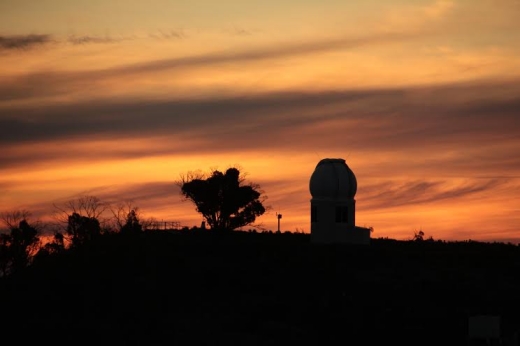
Image: The SkyMapper telescope at sunset. Credit: Steve Chapman.
The project is to be launched by Brian Cox during the BBC’s Stargazing Live broadcast from Siding Spring Observatory, joining other crowdsourced efforts on the Zooniverse site when it becomes available. Bear in mind that we already have Backyard Worlds, a project (likewise on Zooniverse) that uses data from WISE (Wide-field Infrared Survey Explorer) to pursue a similar search, though not targeted as tightly on a single planet. The latter’s animated ‘flipbooks’ are the modern day equivalent of what Tombaugh used for Pluto.
I don’t know what kind of interface the SkyMapper effort will come up with, but it’s pleasing to think of a modern-day analog of the famous Tombaugh search, now spread out over a global network of users. The Stargazing Live series begins on the BBC on March 28 at 2000 UTC. An Australian version of the show will also be broadcast from Siding Spring Observatory next week on ABC TV. Stargazing Live has its own blog page from which to learn more, and ANU Twitter feed @scienceANU is also tracking the rollout.

Astronomy Rewind: Keeping Our Data Alive
When I was growing up, there was a small outbuilding between my house and the stand of woods behind our property. The previous owner had built it as a little house in its own right, everything on a miniature scale, so that while it looked like an actual house — with front door, nice windows, even a porch and small deck on the back — it was comprised of only one room inside. This man’s kids had used it as a playhouse, but when I got my hands on it, I turned it into what a young boy thought of as his ‘lab,’ with microscope, chemistry set and telescope.
On the walls I put photographs I had bought at Chicago’s Adler Planetarium, and I can still see those blurry images of Saturn, Jupiter and the Milky Way, all taken at the Palomar Observatory, and almost as breathtaking for what they didn’t reveal as what they did. I gradually augmented these photos with sky charts and other imagery, and would use these to plan my observing sessions with the 3-inch reflector I would take out into the yard.
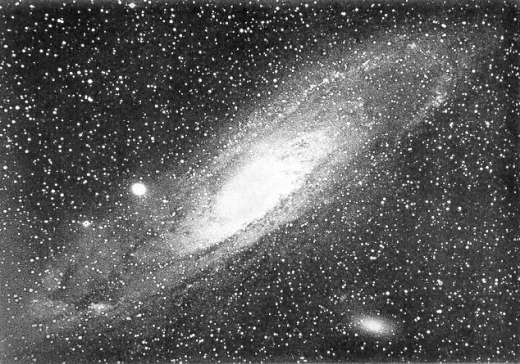
Image: A classic photo (though not one of my Palomar images). This is M31, then known as the Great Andromeda Nebula, its nature as a separate galaxy not being known when the photograph was taken in 1888 by Sir Isaac Roberts. Reproduced in A Selection of Photographs of Stars, Star-clusters and Nebulae, Volume II (The Universal Press, London, 1899), this is the image whose long exposure time first.revealed M31’s spiral structure. Photos like these may look quaint compared to the brilliant detail and color of today’s work, but studying the sky over long periods of time may tease out new information, making even our older datasets useful tools for exploration. Credit: Isaac Roberts.
You would think old astronomical photographs would have a place only in memories like these, but I’m reminded of the vigorous debate that broke out not long ago over the anomalous star KIC 8462852, and Bradley Schaefer’s contention that, on the basis of archival imagery, it could be shown to have undergone a long-term dimming (see KIC 8462852: A Century Long Fade? for more on this — there are likewise numerous articles in the archive).
Schaefer was using a collection of some 500,000 sky photographs in the archives of Harvard College Observatory, covering the period from 1890 to 1989. A program called Digital Access to a Sky Century@Harvard (DASCH) has been digitizing the observatory’s archives, offering a way for astronomers to re-examine historical imagery. DASCH has only digitized a fraction of the archives but it’s a work in progress. What else can we do to reinvigorate such material?
One answer is a project called Astronomy Rewind, whose aim is to restore tens of thousands of astronomical images — photographs, radio maps and other sky-related material — from a wide variety of sources, placing them into context in digital sky atlases and catalogs. The project is part of the Zooniverse platform that gave us Galaxy Zoo a decade ago and now includes ‘citizen science’ projects in a variety of disciplines. Here the idea is to turn our attention to the contents of scientific journals and collate their imagery over time.
American Astronomical Society journals go back to the 19th Century and became accessible electronically in the 1990s. The volunteers will catalog the types of images, separating photographs with and without sky coordinates, maps of planets with or without latitude and longitude grids, graphs and diagrams, focusing on labeled images or those with sufficient detail to make a clear determination of orientation and sky position. Other images will be sent to Astrometry.net, which identifies areas of sky by comparing photos to star catalogs.
The project depends upon human judgement and pattern recognition at a large scale:
“You simply couldn’t do a project like this in any reasonable amount of time without ‘crowdsourcing,'” says Julie Steffen, AAS Director of Publishing. “Astronomy Rewind will breathe new life into old journal articles and put long-lost images of the night sky back into circulation, and that’s exciting. But what’s more exciting is what happens when a volunteer on Zooniverse looks at one of our journal pages and goes, ‘Hmm, that’s odd!’ That’ll be the first step toward learning something new about the universe.”
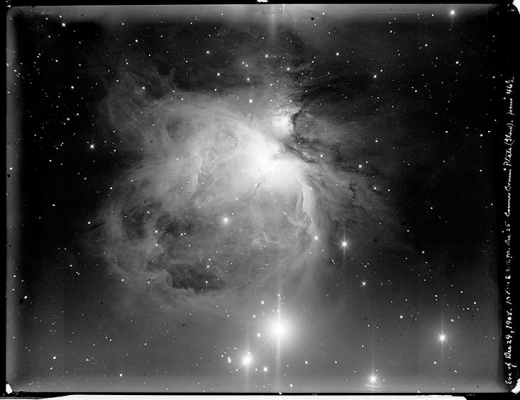
Image: An early view of Orion. This is a digital print of a photographic plate from the Ritchey 60-inch telescope at Mount Wilson Observatory, made in 1908. Credit: Mt. Wilson Observatory.
The journals involved at present are The Astronomical Journal, Astrophysical Journal, Astrophysical Journal Letters and the ApJ Supplement Series. Images are to be annotated and extracted into digital files that will end up in data repositories as well as becoming part of the Astronomy Image Explorer and becoming viewable in the data visualization tool and sky atlas WorldWide Telescope.
Once up to speed, Astronomy Rewind hopes to process 1,000 journal pages daily, with each page examined by at least five different people to produce consensus. This number is based upon other projects at Zooniverse, where 1.6 million volunteers have classified 4 billion images over the last ten years. Peer-reviewed publications, over 100 of them, have flowed from the Zooniverse work, and as the KIC 8462852 story shows, the potential for discovery is here.
We have to remember as we look into old astronomical materials that we continue to accumulate data at a faster and faster rate. We’re learning how to sift through older material as we build the database from which details that may have escaped our attention decades ago can come to light, perhaps to be reinterpreted in the context of subsequent findings. An earlier effort, the ADS All-Sky Survey, was originally set up to analyze imagery from old astronomy papers, but using computers for the job wasn’t always effective. Now we turn volunteer eyes on the cosmos as we bring digital technologies and older printed journals together.

Ceres: Axial Tilt and Surface Ice
Earth’s axial tilt (its obliquity) is 23.5 degrees, a significant fact for those of us who enjoy seasonal change. The ’tilt’ is the angle between our planet’s rotational axis and its orbital axis. If we look at Earth’s obliquity over time, we find a 41,000 year cycle that oscillates between 22.1 and 24.5 degrees. Here the Moon becomes useful, with recent studies showing that without it, Earth’s obliquity could vary by 25° (some earlier analyses took this number much higher).
Now we have new data from the Dawn spacecraft at Ceres relating the dwarf planet’s axial tilt to the locations where frozen water can be found on its surface. This is interesting stuff, because it depends upon the spacecraft’s ability to measure the world it orbits.
“We cannot directly observe the changes in Ceres’ orientation over time, so we used the Dawn spacecraft’s measurements of shape and gravity to precisely reconstruct what turned out to be a dynamic history,” says Erwan Mazarico, a co-author of a paper on this work based at NASA’s Goddard Space Flight Center in Greenbelt, Maryland.
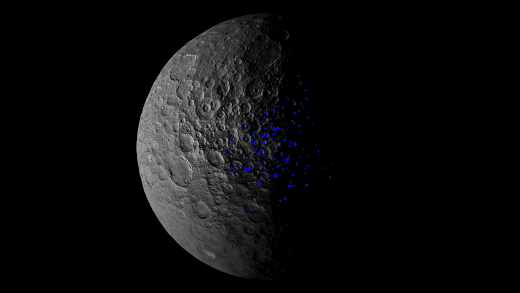
Image: This animation shows how the illumination of Ceres’ northern hemisphere varies with the dwarf planet’s axial tilt, or obliquity. Shadowed regions are highlighted for tilts of 2 degrees, 12 degrees and 20 degrees. Credit: NASA/JPL-Caltech/UCLA/MPS/DLR/IDA.
What we learn from the paper just published in Geophysical Research Letters is that in the last three million years, Ceres’ axial tilt has ranged from 2° to 20°. The last time of maximum obliquity of 19° was about 14,000 years ago, while its current tilt is just 4°, meaning seasonal effects over the course of a current Cerean year (4.6 Earth years) will be slight.
Charting Ceres’ obliquity allows researchers to examine which areas remain most deeply shadowed even during times of maximum tilt, and the current work, led by JPL’s Anton Ermakov, reports that craters that are shadowed during times of maximum obliquity show bright deposits that are most likely water ice. Ceres’ surface temperatures range from 130 to 200 Kelvin (-143° C to -73° C), but regions that rarely see sunlight are more likely to have ice deposits than sunlit areas where ice can sublimate directly into vapor.
Deeply shadowed areas at the poles never receive direct sunlight when Ceres’ axial tilt is as low as it is today — this is an area of about 2,000 square kilometers — but increasing obliquity reduces the shadow region to as little as 1 to 10 square kilometers. The researchers call craters with areas that stay in shadow over long periods of time ‘cold traps’ because volatiles that readily vaporize cannot escape once deposited there. We’ve already learned from Dawn that 10 such craters contain bright material, and one is already known to contain ice.
The northern and southern hemispheres have two persistently shadowed regions each at 20° tilt, and so far we have found bright deposits in three of the four. All of this should call up thoughts of the polar regions of the Moon, a body that has little variability in its tilt because of the influence of the Earth. Mercury, too, stabilized by its proximity to the Sun, shows little axial tilt, and on both objects, we are finding evidence of water ice in shadowed craters at the poles. As with Mercury, the Moon’s ice surely comes from the impact of asteroids and comets, whereas what we find on Ceres may, at least in part, come from the dwarf planet itself.
Remember that the European Space Agency’s Herschel Space Observatory found a tenuous atmosphere on Ceres several years ago, a possible source of water molecules that can accumulate in the cold traps. Meanwhile, note that Ceres’ axial tilt varies on a cycle of about 24,500 years, a figure researchers consider to be a surprisingly short time given the size of the variation. Ceres’ surface ice, then, gives us insight into its geological history as we continue to probe the question of whether the small body continues to give off water vapor.
The paper is Ermakov et al., “Ceres’s obliquity history and its implications for the permanently shadowed regions,” published online by Geophysical Research Letters 22 March 2017 (abstract).

Rosetta: Chronicling Cometary Change
Learning about the changes that occur on a cometary surface over time was a primary goal of the European Space Agency’s Rosetta mission, which orbited comet 67P/Churyumov-Gerasimenko between August 2014 and September 2016. This was a period when the comet was swinging through the inner Solar System as it closed to perihelion. Now we have vivid evidence of the changes the comet experienced as recorded by Rosetta.
Consider a report in Nature Astronomy, which chronicles outburst activity on the comet associated with the spectacular collapse of a cliff face. Located in the Seth region of the comet on a prominent cliff edge was a 70-meter long fracture about 1 meter wide. During the period of observation, as Rosetta drew ever nearer perihelion, buried ices turned to vapor at an increasing rate, pulling dust out into space, with occasional outburst activity. Rosetta observed an outburst on July 10, 2015 that was associated with this region.

Image: Comet cliff collapse before and after. Credit: ESA.
A scant five days later, the place where the fracture had been now showed a bright, sharp edge, with a host of meter-sized boulders at the foot of the 134-meter high cliff that had not been there before. The assumption is that the cliff collapse and outburst were linked. Water ice buried deep inside the comet was thus exposed, to gradually turn to vapor in the following months. The exposed face was found to be six times brighter than the average surface brightness of the cometary nucleus in the period immediately after the event.
Activity like this has a profound effect on the cometary surface. As this ESA news release explains, the material that fell from the cliff and accumulated at its foot weighs in at about 10,000 tonnes, with about 100 tonnes being lost into space. “We see a similar trend at the foot of other cliffs that we have not been so fortunate to have before and after images, so this is an important validation of cliff collapse as a producer of these debris fields,” says Maurizio Pajola (NASA Ames/University of Padova, Italy), who led the new study.
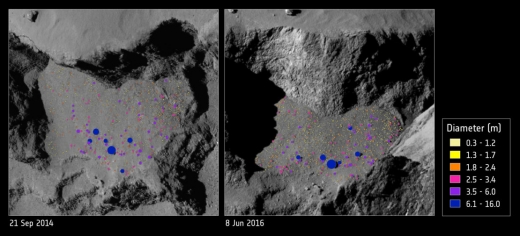
Image: Fallen cliff debris. Credit: ESA.
Researchers believe that daily and seasonal temperature variations may have driven fractures deeper into the subsurface of the comet than was previously thought, making it more vulnerable to the temperature changes of its journey into the inner system. What we have here is a priceless look before and after a major event, confirming the importance of cliff collapses in molding the surface of a comet and perhaps provoking outburst activity. Adds Pajola:
“If the fractures permeated volatile-rich layers, heat could have been transferred to these deeper layers, causing a loss of deeper ice. The gas released by the vapourising material could further widen the fractures, leading to a cumulative effect that eventually led to the cliff collapse. Thanks to this particular event at Aswan, we think that the cumulative effect led by strong thermal gradients could be one of the most important weakening factors of the cliff structure.”
We also have a new study in Science examining the broad range of terrain change on Comet 67P during Rosetta’s two years of close observation. Here numerous processes appear to be at work, each with the potential for working serious change. In situ weathering involves the weakening of materials through the heating and cooling cycle, both daily and seasonal, that can result in gas outflows and cliff collapses like the one we just examined. But we also have forces created by the comet’s spin rate as it moved toward perihelion, thought to have created a new fracture observed by Rosetta.
A previously known fracture some 500 meters long runs through the comet’s neck in the region called Anuket. Although observed in August of 2014, the fracture was found to have become extended by another 30 meters by December of that year. And by June of 2016, the new fracture, 150 to 300 meters long, had opened parallel to the original fracture.
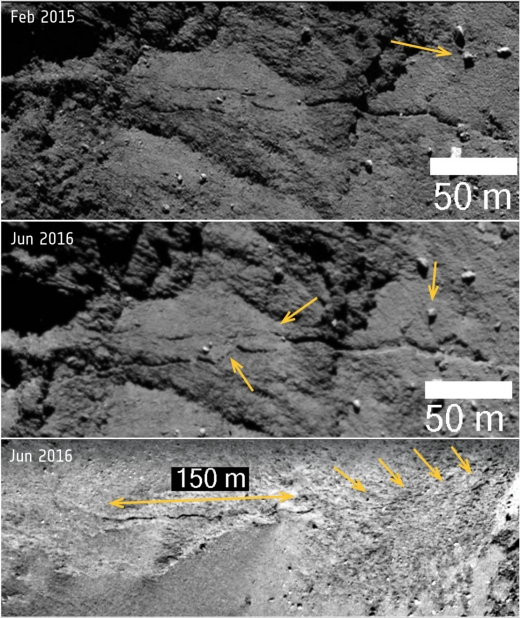
Image: Comet changes: new fracture and boulder movement in Anuket. Credit: ESA.
We also see movement in boulders on the surface of Comet 67P, perhaps linked to the fracture activity, perhaps not. In one case, a boulder 30 meters wide and weighing 12,800 tonnes was observed to have moved 140 meters in the comet’s Khonsu region. This movement is thought to have occurred during the perihelion period, when several outbursts were observed close to the boulder’s position. Erosion of the nearby surface could be the culprit here, allowing the boulder to roll downslope. Equally possible: A strong outburst could have lifted it to its new location.
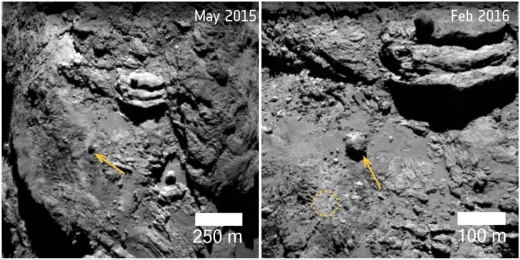
Image: Comet changes: A moving boulder in Khonsu. Credit: ESA.
Sublimation is a major cause of erosion, as is falling dust returning to the surface after an outburst, both of which can sculpt the cometary landscape. In some areas, scarps in several smooth plains have been seen to retreat by tens of meters — as much as a few meters a day during perihelion. Meanwhile, in regions of smooth plains like Comet 67P’s Imhotep, new circular features are found that were once obscured by surface material. The likely cause here is sublimation of underlying ice, which has removed up to 3 meters of material in one area.
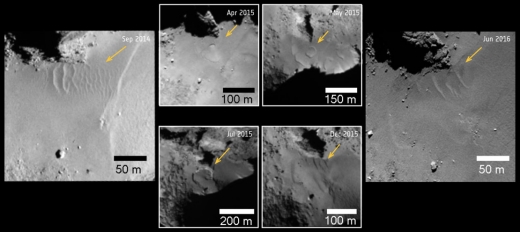
Image: Comet changes: Ripples and scarps in Hapi. Credit: ESA.
The movement on the surface of the comet is strikingly swift. In the comet’s neck region, a smooth area once likened to sand dunes on Earth when first observed, ripple formations began showing expanding circular features that reached diameters of 100 meters over a period of three months. These then faded and gave rise to new sets of ripples. In addition, honeycomb-like features have been observed in the Ma’at region on the comet’s northern hemisphere, showing a marked increase in roughness as perihelion approached.

Image: Comet changes: surface textures in Ma’at. Credit: ESA.
Rosetta shows us that this comet’s surface is geologically active on short and long time-frames, although its overall appearance has not significantly changed, based on ground-based studies conducted over the last few years. Ramy El-Maarry (University of Colorado, Boulder), who led the study, speculates that earlier perihelion passages were far more active, when the comet would have held a higher amount of volatiles and the major landforms on the surface would have attained their current configuration. Whatever the case, Rosetta’s study of Comet 67P’s changing surface vividly shows a surface of growing fractures, evolving cliffs and boulders in motion, a scene we had expected but are now able to analyze in detail for the first time.
The paper on the cliff collapse is Pajola et al., “The pristine interior of comet 67P revealed by the combined Aswan outburst and cliff collapse,” published online by Nature Astronomy 21 March 2017 (full text). The El-Maarry et al. paper is “Surface changes on comet 67P/Churyumov-Gerasimenko suggest a more active past,” published online by Science 21 March 2017 (abstract). This ESA news release is also helpful.

Runaway Stars in Orion
Unexpected things can happen when you’re looking for exoplanets. Ask Kevin Luhman (Penn State), whose search for free-floating planets in the Orion Nebula is now telling us something interesting about star formation in general. In a small region dominated by young stars called the Kleinmann-Low Nebula, some 1300 light years from Earth near the center of the Orion Nebula complex, Luhman and team have come across evidence of a multiple star system whose members have flown rapidly apart due to gravitational interactions with their peers.
Luhman’s team was using the Hubble instrument’s Wide Field Camera 3 to run the planet-hunting survey, working with Massimo Robberto (Space Telescope Science Institute) and a group of international colleagues. A star referenced only as ‘source x’ turned up in a comparison between 2015 imagery in the infrared and infrared observations made in 1998 with the Hubble telescope’s Near Infrared Camera and Multi-Object Spectrometer. The surprise: ‘Source x’ had changed its position substantially in those 17 years.
Working out the star’s velocity, the team concluded that it was moving at about 210,000 kilometers per hour. Moving backwards in time, the researchers could chart the star’s travels, and found that in the 15th Century AD, ‘source x’ had been in the same location in the Kleinmann-Low Nebula as two other runaway stars, known as Becklin-Neugebauer (BN) and “source I,” that are now traveling in opposite directions from each other. Discovered in the infrared in 1967, BN has been found to be moving at 95,000 kilometers per hour, while ‘source I’ is clocked at 35,000 kilometers per hour, deeply shrouded in dust and previously observed only through radio telescope studies.
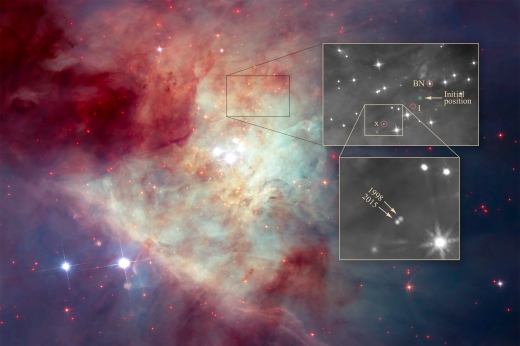
Image: This dramatic view of the center of the Orion Nebula reveals the home of three speedy, wayward stars that were members of a now-defunct multiple-star system. The stellar grouping broke apart 500 years ago, flinging the three stars out of their birthplace. The box just above the Trapezium Cluster outlines the location of the three stars. A Hubble close-up view of the stars is shown at top right. The birthplace of the multi-star system is marked “initial position.” Two of the stars — labeled BN, for Becklin-Neugebauer, and “I,” for source I — were discovered decades ago. Source I is embedded in thick dust and cannot be seen. The third star, “x,” for source x, was recently discovered to have moved noticeably between 1998 and 2015, as shown in the inset image at bottom right. Source x is traveling at an unusually high speed of 210,000 kilometers per hour, which is 30 times faster than the velocity of most stars in the nebula. Credit: NASA, ESA, K. Luhman (Penn State University), and M. Robberto (STScI).
“The new Hubble observations provide very strong evidence that the three stars were ejected from a multiple-star system,” says Luhman. “Astronomers had previously found a few other examples of fast-moving stars that trace back to multiple-star systems, and therefore were likely ejected. But these three stars are the youngest examples of such ejected stars. They’re probably only a few hundred thousand years old. In fact, based on infrared images, the stars are still young enough to have disks of material leftover from their formation.”
All three of these stars are making their way out of the Kleinmann-Low Nebula at high speed, and they may be representative of what happens in young stellar clusters, where the spacing between infant stars is tight. Luhman’s team believes the Orion Nebula could have spawned numerous such interactions, with young stars being ejected from it in great numbers. As to the process at work, it probably results from two members of a multiple star system forming a tight binary or even merging, releasing enough gravitational energy to push all the stars in the system outward and creating a powerful outflow of material. And this bit from the paper on this work is interesting:
Some aspects of the interaction that ejected BN and sources I and x remain unclear, such as how these stars were able to retain or reform their circumstellar disks (Goddi et al. 2011; Plambeck & Wright 2017) and the source of their current kinetic energy… [T]he latter has been previously attributed to the gravitational potential energy released by a pair of stars forming a tight binary or merging, likely in what is now source I. The energy produced by the merger of stars with a total mass of source I (e.g., 1 and 6 M?) is an order of magnitude greater than the kinetic energy of the three stars, so that remains a plausible explanation.
Note that comment about circumstellar disks — how could stars undergoing this kind of gravitational upheaval maintain their disks? The paper’s earlier reference to the problem seems understated, and references another star, ‘source n,’ explained below: “It is challenging to explain the presence of the circumstellar disks around BN and sources I and n if they experienced interactions that were sufficiently close to produce the rapid ejection of BN.”
Challenging indeed, and doubtless the subject of further study. Such disks do indeed mark the youth of the stars involved, but we have a lot to learn about how these interactions would affect material around the stars themselves. Reminding us of the complexity of such analysis, the ‘source n’ mentioned above is yet another star with high proper motion, but one which Luhman and colleagues believe did not participate in the events affecting the other three.
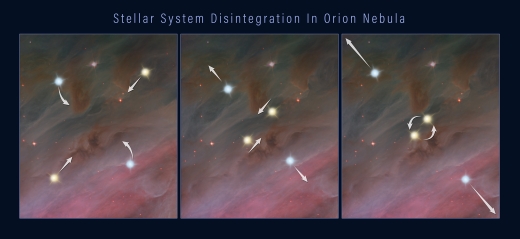
Image: This three-frame illustration shows how a grouping of stars can break apart, flinging the members into space. The first panel shows four members of a multiple-star system orbiting each other. In the second panel, two of the stars move closer together in their orbits. In the third panel, the closely orbiting stars eventually either merge or form a tight binary. This event releases enough gravitational energy to propel all of the stars in the system outward, as shown in the third panel. Credit: NASA, ESA, and Z. Levy (STScI).
It’s not often that we run into stellar phenomena that we can relate to events within our own written history, but here we have a date — 1475 plus or minus 6 years — that takes us back to a time when the Wars of the Roses convulsed England. Somewhere not long before the death of Edward IV, with his brother Richard III waiting in the wings and all hell about to (again) break loose, this distant star system was itself convulsed, its component parts flung into the deep. Finding ‘source x’ and relating it to its fast-moving cousins BN and ‘Source I” answers the puzzle of their motion and reminds us how violent early stellar evolution can be.
The paper is Luhman et al., “New Evidence for the Dynamical Decay of a Multiple System in the Orion Kleinmann-Low Nebula,” Astrophysical Journal Letters Vol. 838, No. 1 (16 March 2017). Abstract / preprint.

